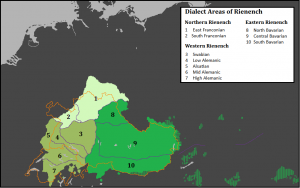Rienench
Rienench (Rienenche, /rɪːnɛnxə/) is a Northern Romance language spoken in Bavaria and Helvetia.
| Rienench (Rienenche) | |
|---|---|
| Spoken in: | Bavaria Helvetia |
| Total speakers: | 39.1 million |
| Language family: | Indo-European Italic |
| Extra information | |
| Author: | Peter Collier | ✎ |
Geographic Distribution
History
The history of Rienench as separate language from Romance begins in the early Middle Ages with the Northern Romance Consonant Shift. Old Rienench, Middle Rienench and Early Modern Rienench span the duration of the Holy Roman Empire. The 19th and 20th centuries saw the rise of Standard Rienench and a decrease of dialectal variety.
Old Rienench
The earliest testimonies of Old Rienench are from scattered 6th century inscriptions, especially in Rhine Franconian, the earliest glosses date to the 8th century and the oldest coherent texts, such as the Stratkarter Oaths to the 9th century.
Middle Rienench
Middle Rienench is the term used for the period in the history of the Rienench language between approximately 1050 and 1350. It is preceded by Old Rienench and followed by Early Modern Rienench.
Early Modern Rienench
When Luter translated the Bible in the 16th century he based his translation mainly on this already developed language, which was the most widely understood language at this time. This language was based on northern (i.e. Franconian) dialects and preserved much of the grammatical system of Middle Rienench. In the beginning, copies of the Bible had a long list for each region, which translated words unknown in the region into the regional dialect. It took until the middle of the 18th century to create a standard that was widely accepted, thus ending the period of Early Modern Rienench.
19th century and beyond
Rienench was the language of commerce and government in the Bavaro-Hungarian Empire, which encompassed a large area of Central and Eastern Europe until the early 20th century. Before the mid-19th century Rienench was essentially the language of townspeople throughout most of the Empire. It indicated that the speaker was a merchant, an urbanite, rather than his nationality. A few cities excepted, such as Milan, most cities were primarily Rienench-speaking during the imperial period, though they were surrounded by territory where other languages were spoken. Some cities, such as Prague and Budapest, were gradually Rienenched in the years after their abssorption into the Thalkarten lands. Others, such as Bratislava, were originally settled during the Thalkarten period and thus were primarily Rienench-speaking from the beginning.
Until about 1800, standard Rienench was almost solely a written language. At this time, people from region to region spoke dialects very different from standard Rienench and learnt it almost as a foreign language, trying to pronounce it as close to the spelling as possible. Prescriptive pronunciation guides of that time considered Viennese pronunciation to be the standard. However, the actual pronunciation of standard Rienench varied from region to region.
Today, media and written works are almost all produced in standard Rienench, which is understood in all Rienench-speaking areas (except by pre-school children in areas where only dialect is spoken, for example in central Helvetia).
Classification
Rienench is a member of the northern branch of the Romance language family, which in turn is part of the Indo-European language family.
Official status
Standard Rienench is the only official language in Bavaria; and it shares official status in Helvetia (with French, Italian and Romansch). It is used as a local official language in Rienench-speaking regions of France, Italy and Saxony. It is one of the 24 official languages of the European Union.
It is also a minority language in Canada, Croatia, the Czech Republic, Hungary, Romania, Slovakia, Slovenia and the United States.
Rienench was once the lingua franca of Central and Eastern Europe and remains one of the most popular foreign languages in Europe.
